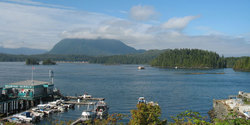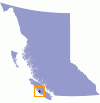
The surrounding forests of old-growth cedar make shelter to the areas wilderness creatures (eagle/deer/bear/cougar), however this region of virgin timberlands on the west coast of Vancouver Island has been guarded from logging and large development by its loving locals who want to see these trees continue to thrive here for generations to come.
Local fishing boats and the dock sides are bustling with activity year round. Kayaking, whale watching, and sailing/charters are both informative to visitors and give a glimpse of the amazing ecosystems which exist in Tofino.
There are also small surrounding island for which small boats must sent supplies to the five Nuu-chah-nulth First Nations communities and others who make the remote shores of Clayoquot Sound’s lifestyle their own.
Families love the unique camping spots and accommodations. Couples enjoy the complete escape to peace and tranquility in a cozy cottage or a five star suite. The daily culture and eco-tours share a priceless experience found no where else. The quaint roadside stops and village strip offer shops and hand crafted goods and basic necessities. Guests will find bicycle and surf board rentals available as well as local charter services.
Population: 1,600
Highlights:
The abundant works in carvings, totem poles, hand crafts, baskets, pottery, sculptures, metal work, glass and jewelry designed and created in the traditional practices of the First Nations by members living in the area are considered a trip highlight to those who seek to learn more about the cultures that thrived here off the lands for over four thousand years.
Artists / Culture /First Nations Art
Storm Watching (Nov – Feb)
Surfing Year Round
Fishing
First Nations Culture Tours
Native-run galleries; Eagle Aerie Gallery & House of Himwitsa
Diving Charters
Hot Springs
History:
Tribal families of the Nuu-chah-nulth who populated the area for thousands of years prior to the arrival early white settlers still live in the area of Tofino or on the surrounding islands. The sources of nourishment from the land; berries and roots (some game), the shelter of the cedar trees and the oceans ample sources of fishing provided them with means to survive along the coast year round. Sometimes a number of the members would travel by hand-hewn cedar canoe in search of summer food collection (in preparation for winter) would be sent to areas where larger numbers of salmon or fish would be running. The coast was scattered with temporary village sites established during these peeks seasons.
Named, in 1792 after the Rear Admiral of the Spanish Naval Academy Vincente Tofino de San Miquel, Tofino was originally a home to a trading post and hotel to accommodate the arrival and transport of European settlers in the late 1800’s. Eventually, in 1959, the shore side community
Climate:
Summer average 16 degrees Celsius
Winter average 2 degrees Celsius (rainy generally)

